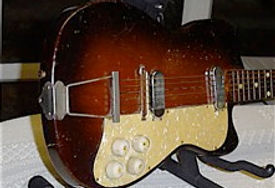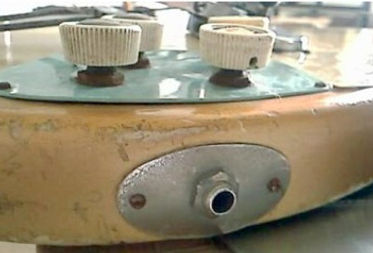A HISTORY OF BROADWAY GUITARS
A History of Broadway Guitars
1959


Broadway BW1 & BW2
The story begins in late '50s Britain, when Broadway became the brand name, belonging to and marketed by UK importers and distributors, Rose-Morris. The brand name was applied to many musical instruments and from various sources, during the 1950s right through to the early 1960s. It was used on electric guitars and related equipment, drum kits, keyboards and amplifiers, which either came from the UK itself.or on instruments imported from Germany and more especially, from Japan.
In an early instrument catalogue, from UK distributor Stanley Lewis and dated around 1960, there are two rather primitive UK made, solid electric guitars; the Broadway BW1 and BW2, both of which being rather similar in style to the earlier Dallas Tuxedo model. The Dallas Tuxedo guitar began prototype manufacture in 1957 and was marketed by Dallas Arbiter of London. From its introduction to the UK on 25th April 1959, the Dallas Tuxedo became the third British made, solid body electric guitar to commercially hit the market, following in the wake of the Supersound ('Ike Isaacs Short-Scale' model, was introduced in December 1958) and the Burns-Weill Fenton (early 1959). Closely behind came the single pickup Broadway BWI and the sister two pickup BW2, (referred to as the Broadway Solid Model No.1 & No 2 in the Bell Music guitar catalogue of 1960).



The Broadway guitars BW1 and BW2 were of solid wood construction, finished in either a brown sunburst, with a sparkle finish pearloid scratchplate or in a cream blonde burst, with a white, gold sparkle or split blue and white pearloid scratch plate. The fretboard was in rosewood, with an ebony nut at the headstock end. The characteristic 'Broadway' logo is in a raised plastic material glued in place or stencil painted onto the front upper bout of the guitar's body, rather than portrayed on the headstock. A volume and tone control, of white plastic with a gold insert for each pickup, was a typical feature. A simple trapeze tailpiece and a rather primitive bridge completed the guitar and any adjustment to the guitar's intonation was very limited and only achieved by moving the bridge in the desired direction. Three-a-side open back tuners complete the headstock adornment.
These Broadway BW1 and BW2s almost certainly came from the factory of Stuart Darkins & Co., a furniture maker based at Shoeburyness, in Essex. Darkins also produced solid body electrics for other guitar manufacturers of the time, including Vox, Hohner and Fenton Weil, as well as the aforementioned Dallas Tuxedo. The Broadway BW1 and BW2 was manufactured from 1959, into the early '60s. Darkins was a well-known furniture maker, who clearly saw opportunities to branch out into the burgeoning music scene of rock and roll and his factory became instrumental (no pun intended!) in producing guitars that quickly became part of the history of British musical instruments.
The pickups, without question, are those manufactured by Henry Weill, who is also associated with Burns-Weill, Fenton-Weill and eventually Vox. It has to be remembered that this was literally a cottage industry in Britain of the latter 1950s; demand for solid electrics was still small, albeit rapidly growing but facilities, materials and know-how were in equally short supply.




The photos above show a brown sunburst Broadway guitar BW1, with the Broadway logo just about discernible on the guitar's upper bout.
The BW2 on the right has non-original volume and tone control knobs, controlling the two pickups.







An early Blonde burst BW2
My own acquisition of a very rare, early BW2 came about through an enquiry, relating to the owner inheriting the guitar and wishing to identify it and its value. The owner was considering selling it and the rest is history!.
Although requiring some tuner parts, a new nut (the original ebony nut had broken), and a few other missing parts, essentially the guitar was in surprisingly good shape, with no neck issues and no fret wear.
The guitar displays the gold sparkle scratch plate, one of the rarer options. The truss rod cover has now been replaced with a suitable gold sparkle replacement, to replicate the original look of this stunning model. It arrived with a red Fablon truss rod cover, clearly not original!
Thanks to Alan Exeley of projectguitarparts.co.uk
for finding the replacement machine head parts, which allowed the restoration of this guitar to take place.
The 'teardrop' case is original and lined in a very thin red felt. This was an additional item at the point of purchase of the guitar and cost 2 1/2 (Two and a half) guineas extra, being 2 pounds and two shillings in pre-decimal currency.





The blonde-burst BW2 shown here is owned by Guy Mackenzie. It features an addition in the form of a Framus engraved palm tremolo device, fitted to the standard trapeze tailpiece. Guy commented 'the Framus add-on vibrato is amazing but of course, puts the guitar out of tune when used!'.
Guy has several Broadway guitars in his large collection, which can be found at http://www.theguitarcollection.org.uk
Guy and I were unaware that we were bidding against each other for this rare guitar when it appeared on eBay in 2009! Luckily, this increasingly rare guitar has found a very good home.






The page on the left, is from the very first catalogue of Bell Music of Surbiton, Surrey. Dated November 1960, it shows the Broadway solid model (BW2) retailing at 19 gns (a guinea being one pound and one shilling in pre-decimal currency), with it's one pickup sister guitar (the BW2) 141/2 gns. A felt lined fibre case was 21/2 gns extra!
The front cover of the Bell Music catalogue is shown below and dated 11/60 (i.e. November 1960).


I stumbled across this photo from a website called www.walthamstowmemories.net. The title of the site says it all and the kind permission has been given to use the photo, that shows a band playing at the William Morris Hall, Walthamstow, probably in the late 1950s/early 60s. There’s not much information provided, except that the band centres on local drummer, Ian Purdy and which included a guitarist, called John (?), who played a Broadway guitar through a Watkins amp. The guitar is undoubtedly a Broadway BW2. I should imagine there’s not many photos of this guitar being played in existence and it’s good to see one, for historic reasons alone.




The photograph on the left shows The Senators, a beat group from Gorton in south east Manchester.
Here they're found playing at Brookfield Church, in Gorton, at their Christmas Party in January 1962. Their guitarist, Alan Herricks, is found sporting a rather splendid Broadway BW2 in blonde-burst. Lovely!





The images (left) of the sunburst BW1 were sent by Mark Harvey, a keen collector of '60s and '70s guitars.
Mark acquired this guitar in the summer of 2014, purchasing it from it's former owner, who supplied the photos.
It's a great example of a very rare, early British electric.
Thanks to Mark for suppling the photos and background info.


BWI rare photo
A rare photo of a sunburst Broadway BW2, being played by the late John Bradbury (1947-2016), from Chesterfield, in Derbyshire .
The photo was sent by his son, Richard, who only recently discovered this photo and had searched in vain for the 'identity' of the guitar, until stumbling across this website. The photo probably heralds from the early '60s.



Early BW2
Found on the ubiquitous eBay site in September 2021, was another example of one of the earliest British made solid body electric guitars - a 1959-1960 (serial # 827) Broadway BW2, this model with the white scratch plate.
It's a rare beast, of course but this one was being sold from the USA, with a price tag of $899.00 + shipping and being sold with its original 'teardrop' case, too.
The current owner, bought it to the USA with him, from England. The # 827 on the edge of the headstock could possibly be related to the year of production (1958, No. 27), if it followed the pattern established by Fenton Weill guitars. However, with Dallas Arbiter showcasing their Dallas Tuxedo in April 1959 as the first British solid electric, the date stamped on this Broadway for 1958 seems unlikely. As ever, a lack of documentation or firm evidence about this historic period of British guitar manufacturing, is sadly missing.
Below: Emerging evidence of another variant on the BWI. This is the Blonde Burst / blue sparkle guard and seldom seen since production in 1960.


